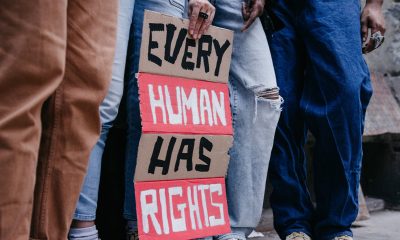National
NYC Jail Guards Use of Force a Record in 2014

In this Dec. 17, 2014 file photo, New York City Mayor Bill de Blasio, center left, meets with youth offenders as Acting Deputy Commissioner of Youthful Offenders, Adult Programming and Community Partnerships Winette Saunders-Halyard, center, and Department Correction Commissioner Joe Ponte, right, look on, at Second Chance Housing which serves as alternative housing for incarcerated adolescents on Rikers Island in New York. (AP Photo/The Daily News, Susan Watts, Pool, File)
JAKE PEARSON, Associated Press
NEW YORK (AP) — New York City jail guards reported more use of force against inmates in 2014 than ever before — an average of 11 incidents a day ranging from pepper sprayings to punches — amid heightened scrutiny from federal prosecutors to clean up what they call a “deep-seated culture of violence.”
Figures obtained Wednesday by The Associated Press via a public records request show correction officers reported using force 4,074 times last year, including 406 incidents alone in September, the month after a scathing federal report that said Rikers Island guards too often resorted to force against teenage inmates.
“There has clearly not been a commitment to date to address officer violence on Rikers Island,” said Dr. Bobby Cohen, a member of the jail oversight board who alluded to the record rates at a public meeting Tuesday. “Will that change now? I hope so. I’ve certainly not seen that before.”
The figures come the same day federal prosecutors, who have since sued to speed up the pace of reforms at Rikers, begin three days of negotiations with city lawyers and correction officials over specific language on use-of-force policy, investigations and other jail problems.
Federal prosecutors declined to comment on the data. A jail spokesman said in a statement that city Correction Commissioner Joseph Ponte has a zero tolerance for excessive force and is updating the department’s use-of-force policy, improving staff training, expanding the investigation division and installing security cameras. He said those efforts and others likely will result in fewer incidents in the coming months.
Officers are required to fill out use-of-force forms every time there’s a confrontation with inmates, including when they are separating two or more inmates fighting each other. The data include the entire range of incidents from minor to serious use of force but don’t describe what happened in each case.
Use of force ranges from so-called Class C incidents such as pepper sprayings that result in minor to no injuries, to Class B incidents such as bruises and swelling that can be treated with over-the-counter care, to Class A incidents such as broken bones and deep cuts that require hospitalization.
Norman Seabrook, who heads the powerful 9,000-member Correction Officers’ Benevolent Association, said the rise in reported incidents was likely attributable to guards documenting more often than they did previously in an effort to cover themselves from potential lawsuits and discipline, even if they’re legitimately defending themselves from attacks.
“If I physically touch an inmate, it’s a use of force irrespective of an injury happening,” he said. “Absolutely we’re saying, ‘Document everything. Don’t physically get into an altercation but use chemical agents. Spray them. Spray everybody you’ve got to spray but don’t punch nobody out. Just spray whoever you’ve got to.'”
But inmate advocates and others point to the scathing August review by federal prosecutors that described a “deep-seated culture of violence” at Rikers, finding that guards regularly used physical force against 16- 17- and 18-year-old inmates often for perceived slights and signs of disrespect. The report said that behavior likely held true in all of the 10 facilities on Rikers, a massive jail complex in the East River that holds an average of nearly 11,000 inmates a day on charges ranging from trespassing to murder.
One such incident occurred last month, the week before a visit from Mayor Bill de Blasio, who has vowed to reform the nation’s second-largest jail system, according to an attorney for inmate Ambrorix Celeeomio.
Celeeomio, 18, who is being held on a gang assault charge, was pepper sprayed, punched and kicked by guards December 9 in a Rikers cafeteria without cameras after getting into an argument with a jail guard, according lawyer Jenay Nurse, who heads The Bronx Defenders’ Adolescent Defense Project. She said Celeeomio, who has an IQ of 65 and is cognitively delayed, was rushed to a Rikers clinic covered in blood.
A city official, who wasn’t authorized to speak about the incident, confirmed that Celeeomio was involved in the use-of-force with at least two correction officers that day.
The data also show use-of-force rates have increased steadily in the past eight years even as the overall inmate population has declined. Guards reported 3,285 uses of force in 2013 when the inmate population averaged 11,687. There were 1,299 reports in 2006 when there were nearly 14,000 inmates.
Plaintiff’s attorneys and others have long argued the city jails are consumed by violence and the AP reported last year based on a health department study that a third of inmates who said their visible injury resulted from a confrontation with jail guards suffered a blow to the head.
Inmate slashings and stabbings have also increased from a low of 19 incidents in 2007 to 93 last year, according to the data. But they’re down from a high of 1,552 incidents in 1990 when the jail population was 20,207 inmates.
Copyright 2015 The Associated Press. All rights reserved. This material may not be published, broadcast, rewritten or redistributed.
Activism
Ann Lowe: The Quiet Genius of American Couture
Lowe was born in Clayton, Alabama, into a family of gifted seamstresses. Her mother and grandmother were well-known dressmakers who created exquisite gowns for women in the area. By the time Lowe was a young girl, she was already showing extraordinary talent — cutting, sewing, and decorating fabric with a skill that far exceeded her age. When her mother died unexpectedly, Lowe – only 16 years old then – took over her mother’s sewing business, completing all the orders herself.
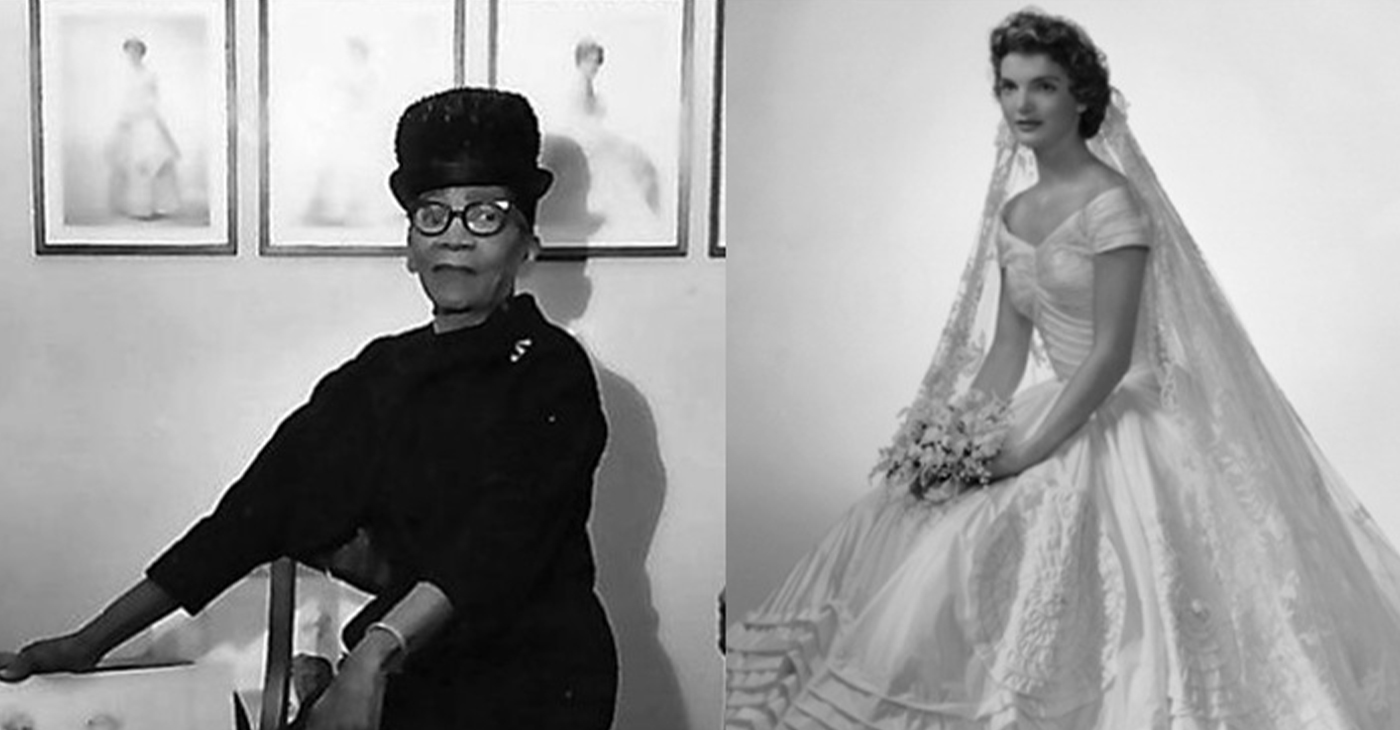
By Tamara Shiloh
Ann Cole Lowe, born Dec.14, 1898, was a pioneering American fashion designer whose extraordinary talent shaped some of the most widely recognized and celebrated gowns in U.S. history.
Although she designed dresses for society’s wealthiest families and created masterpieces worn at historic events, Lowe spent much of her life in the shadows — uncredited, underpaid, yet unmatched in skill. Today, she is celebrated as one of the first nationally recognized African American fashion designers and a true visionary in American couture.
Lowe was born in Clayton, Alabama, into a family of gifted seamstresses. Her mother and grandmother were well-known dressmakers who created exquisite gowns for women in the area. By the time Lowe was a young girl, she was already showing extraordinary talent — cutting, sewing, and decorating fabric with a skill that far exceeded her age. When her mother died unexpectedly, Lowe – only 16 years old then – took over her mother’s sewing business, completing all the orders herself. This early responsibility would prepare her for a lifetime of professional excellence.
In 1917, Lowe moved to New York City to study at the S.T. Taylor Design School. Although she was segregated from White students and forced to work separately, she, of course, excelled, graduating earlier than expected. Her instructors quickly recognized that her abilities were far above the typical student, especially her skill in hand-sewing, applique, and intricate floral embellishment – techniques that would become her signature.
Throughout the 1920s and 1930s, she designed gowns for high-society women in Florida and New York, operating boutiques and working for prestigious department stores. Her reputation for craftsmanship, originality, and elegance grew increasingly. She was known for creating gowns that moved beautifully, featured delicate hand-made flowers, and looked sculpted rather than sewn. Many wealthy clients specifically requested “an Ann Lowe gown” for weddings, balls, and galas.
Her most famous creation came in 1953: the wedding gown worn by Jacqueline Bouvier when she married Massachusetts Sen. John F. Kennedy. The dress – crafted from ivory silk taffeta with dozens of tiny, pleated rosettes – became one of the most photographed bridal gowns in American history. Despite this achievement, Lowe received no public credit at the time. When a flood destroyed her completed gowns 10 days before the wedding, she and her seamstresses worked day and night to remake everything – at her own expense. Her dedication and perfectionism never wavered.
She eventually opened “Ann Lowe Originals,” her own salon on New York’s Madison Avenue. She served clients such as the Rockefellers, DuPonts, Vanderbilts, and actresses like Olivia de Havilland. Yet even with her wealthy clientele, she struggled financially, often undercharging because she wanted every dress to be perfect, even if it meant losing money.
Lowe’s contributions were finally recognized later in life. Today, her exquisite gowns are preserved in museums, including the Smithsonian National Museum of African American History and Culture and the Metropolitan Museum of Art.
In the last five years of her life, Lowe lived with her daughter Ruth in Queens, N.Y. She died at her daughter’s home on Feb. 25, 1981, at the age of 82, after an extended illness.
Activism
Oakland Post: Week of December 10 – 16, 2025
The printed Weekly Edition of the Oakland Post: Week of – December 10 – 16, 2025
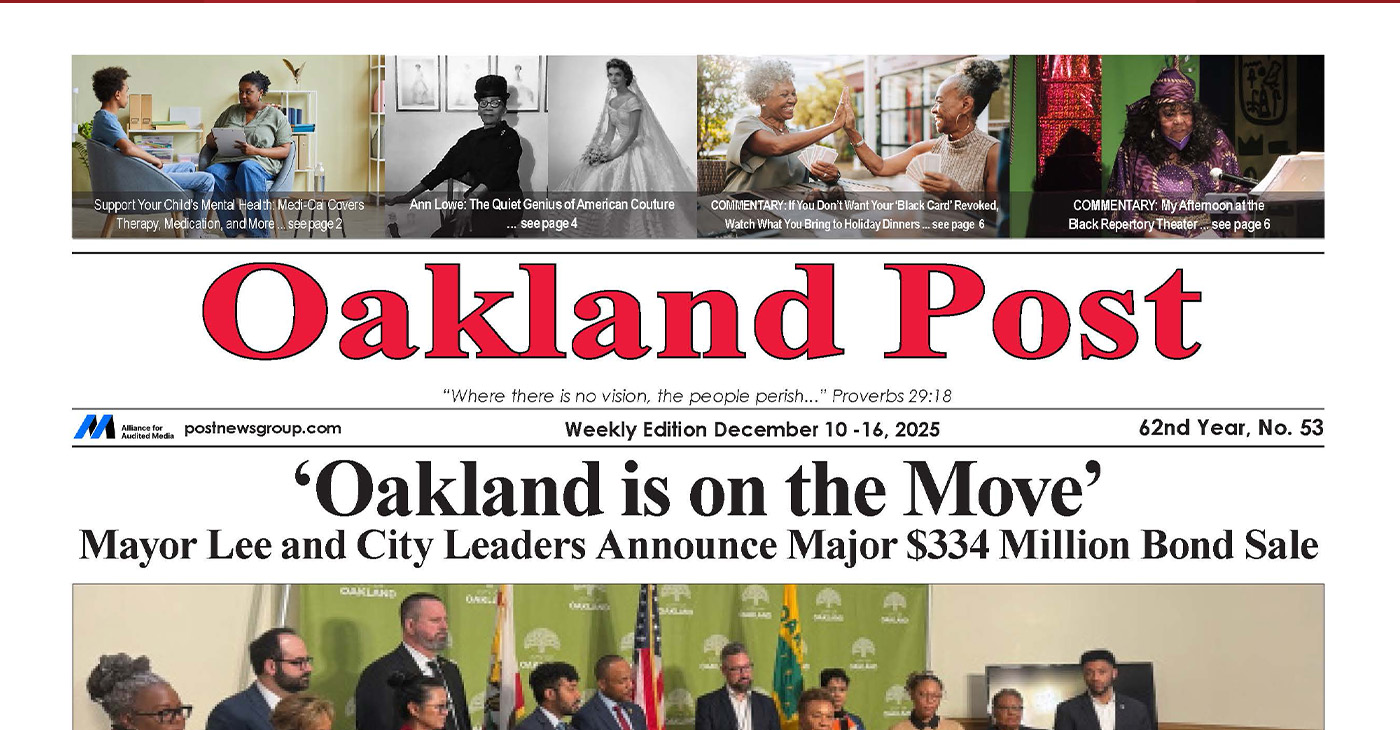
To enlarge your view of this issue, use the slider, magnifying glass icon or full page icon in the lower right corner of the browser window.
Alameda County
Seth Curry Makes Impressive Debut with the Golden State Warriors
Seth looked comfortable in his new uniform, seamlessly fitting into the Warriors’ offensive and defensive system. He finished the night with an impressive 14 points, becoming one of the team’s top scorers for the game. Seth’s points came in a variety of ways – floaters, spot-up three-pointers, mid-range jumpers, and a handful of aggressive drives that kept the Oklahoma City Thunder defense on its heels.

By Y’Anad Burrell
Tuesday night was anything but ordinary for fans in San Francisco as Seth Curry made his highly anticipated debut as a new member of the Golden State Warriors. Seth didn’t disappoint, delivering a performance that not only showcased his scoring ability but also demonstrated his added value to the team.
At 35, the 12-year NBA veteran on Monday signed a contract to play with the Warriors for the rest of the season.
Seth looked comfortable in his new uniform, seamlessly fitting into the Warriors’ offensive and defensive system. He finished the night with an impressive 14 points, becoming one of the team’s top scorers for the game. Seth’s points came in a variety of ways – floaters, spot-up three-pointers, mid-range jumpers, and a handful of aggressive drives that kept the Oklahoma City Thunder defense on its heels.
One of the most memorable moments of the evening came before Seth even scored his first points. As he checked into the game, the Chase Center erupted into applause, with fans rising to their feet to give the newest Warrior a standing ovation.
The crowd’s reaction was a testament not only to Seth’s reputation as a sharpshooter but also to the excitement he brings to the Warriors. It was clear that fans quickly embraced Seth as one of their own, eager to see what he could bring to the team’s championship aspirations.
Warriors’ superstar Steph Curry – Seth’s brother – did not play due to an injury. One could only imagine what it would be like if the Curry brothers were on the court together. Magic in the making.
Seth’s debut proved to be a turning point for the Warriors. Not only did he contribute on the scoreboard, but he also brought a sense of confidence and composure to the floor.
While their loss last night, OKC 124 – GSW 112, Seth’s impact was a game-changer and there’s more yet to come. Beyond statistics, it was clear that Seth’s presence elevated the team’s performance, giving the Warriors a new force as they look to make a deep playoff run.
-
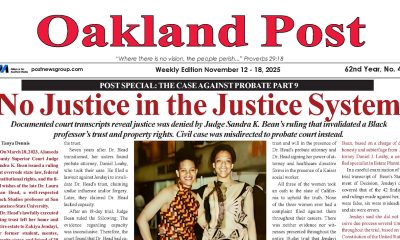
 Activism4 weeks ago
Activism4 weeks agoOakland Post: Week of November 12 – 18, 2025
-

 Activism4 weeks ago
Activism4 weeks agoIN MEMORIAM: William ‘Bill’ Patterson, 94
-

 Activism4 weeks ago
Activism4 weeks agoHow Charles R. Drew University Navigated More Than $20 Million in Fed Cuts – Still Prioritizing Students and Community Health
-

 Bay Area4 weeks ago
Bay Area4 weeks agoNo Justice in the Justice System
-

 #NNPA BlackPress3 weeks ago
#NNPA BlackPress3 weeks agoBeyoncé and Jay-Z make rare public appearance with Lewis Hamilton at Las Vegas Grand Prix
-

 #NNPA BlackPress3 weeks ago
#NNPA BlackPress3 weeks agoLewis Hamilton set to start LAST in Saturday Night’s Las Vegas Grand Prix
-
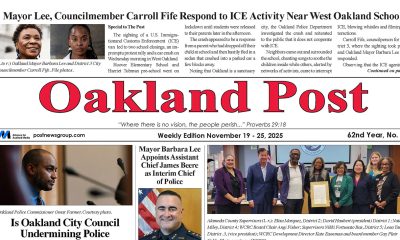
 Activism3 weeks ago
Activism3 weeks agoOakland Post: Week of November 19 – 25, 2025
-

 #NNPA BlackPress2 weeks ago
#NNPA BlackPress2 weeks agoLIHEAP Funds Released After Weeks of Delay as States and the District Rush to Protect Households from the Cold







